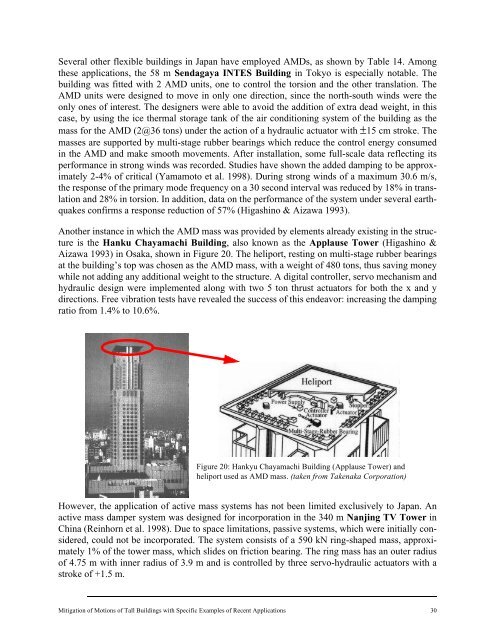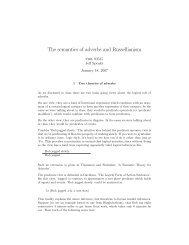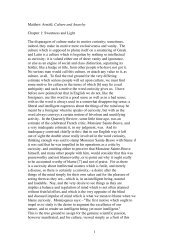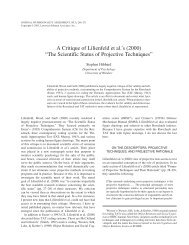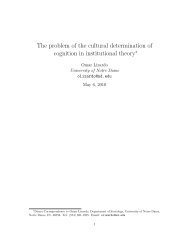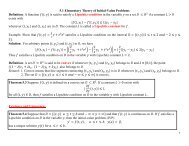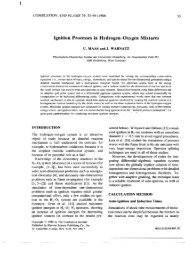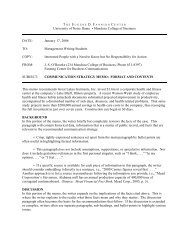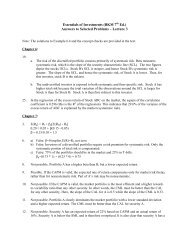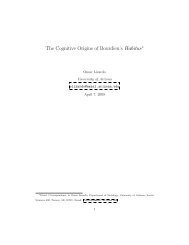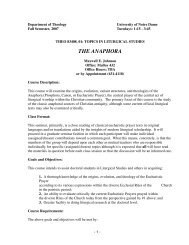Mitigation of Motions of Tall Buildings with Specific Examples of ...
Mitigation of Motions of Tall Buildings with Specific Examples of ...
Mitigation of Motions of Tall Buildings with Specific Examples of ...
Create successful ePaper yourself
Turn your PDF publications into a flip-book with our unique Google optimized e-Paper software.
Several other flexible buildings in Japan have employed AMDs, as shown by Table 14. Among<br />
these applications, the 58 m Sendagaya INTES Building in Tokyo is especially notable. The<br />
building was fitted <strong>with</strong> 2 AMD units, one to control the torsion and the other translation. The<br />
AMD units were designed to move in only one direction, since the north-south winds were the<br />
only ones <strong>of</strong> interest. The designers were able to avoid the addition <strong>of</strong> extra dead weight, in this<br />
case, by using the ice thermal storage tank <strong>of</strong> the air conditioning system <strong>of</strong> the building as the<br />
mass for the AMD (2@36 tons) under the action <strong>of</strong> a hydraulic actuator <strong>with</strong> ±15 cm stroke. The<br />
masses are supported by multi-stage rubber bearings which reduce the control energy consumed<br />
in the AMD and make smooth movements. After installation, some full-scale data reflecting its<br />
performance in strong winds was recorded. Studies have shown the added damping to be approximately<br />
2-4% <strong>of</strong> critical (Yamamoto et al. 1998). During strong winds <strong>of</strong> a maximum 30.6 m/s,<br />
the response <strong>of</strong> the primary mode frequency on a 30 second interval was reduced by 18% in translation<br />
and 28% in torsion. In addition, data on the performance <strong>of</strong> the system under several earthquakes<br />
confirms a response reduction <strong>of</strong> 57% (Higashino & Aizawa 1993).<br />
Another instance in which the AMD mass was provided by elements already existing in the structure<br />
is the Hanku Chayamachi Building, also known as the Applause Tower (Higashino &<br />
Aizawa 1993) in Osaka, shown in Figure 20. The heliport, resting on multi-stage rubber bearings<br />
at the building’s top was chosen as the AMD mass, <strong>with</strong> a weight <strong>of</strong> 480 tons, thus saving money<br />
while not adding any additional weight to the structure. A digital controller, servo mechanism and<br />
hydraulic design were implemented along <strong>with</strong> two 5 ton thrust actuators for both the x and y<br />
directions. Free vibration tests have revealed the success <strong>of</strong> this endeavor: increasing the damping<br />
ratio from 1.4% to 10.6%.<br />
Figure 20: Hankyu Chayamachi Building (Applause Tower) and<br />
heliport used as AMD mass. (taken from Takenaka Corporation)<br />
However, the application <strong>of</strong> active mass systems has not been limited exclusively to Japan. An<br />
active mass damper system was designed for incorporation in the 340 m Nanjing TV Tower in<br />
China (Reinhorn et al. 1998). Due to space limitations, passive systems, which were initially considered,<br />
could not be incorporated. The system consists <strong>of</strong> a 590 kN ring-shaped mass, approximately<br />
1% <strong>of</strong> the tower mass, which slides on friction bearing. The ring mass has an outer radius<br />
<strong>of</strong> 4.75 m <strong>with</strong> inner radius <strong>of</strong> 3.9 m and is controlled by three servo-hydraulic actuators <strong>with</strong> a<br />
stroke <strong>of</strong> +1.5 m.<br />
<strong>Mitigation</strong> <strong>of</strong> <strong>Motions</strong> <strong>of</strong> <strong>Tall</strong> <strong>Buildings</strong> <strong>with</strong> <strong>Specific</strong> <strong>Examples</strong> <strong>of</strong> Recent Applications 30


